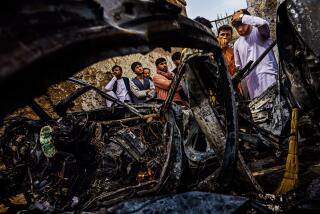Pakistan’s Taliban leader survived U.S. drone missile
- Share via
Reporting from Islamabad, Pakistan — Security sources confirmed Thursday that Pakistani Taliban leader Hakimullah Mahsud is alive, reversing their assertions earlier this year that he had been killed in a U.S. drone missile strike.
The disclosure that Mahsud, 28, survived a January strike near the border between North and South Waziristan deals a major blow to U.S. and Pakistani efforts to uproot Islamic militants from their stronghold in the largely ungoverned tribal areas along the Afghan border.
“He’s alive. He’s got some minor injuries,” said a Pakistani security source who spoke on the condition of anonymity because he is not authorized to discuss such issues. The source said Mahsud is believed to be hiding somewhere in the tribal areas, but would not specify which district authorities believe he is in.
The drone strike targeting Mahsud in mid-January came amid a series of similar attacks carried out by the U.S. in the aftermath of the Dec. 30 suicide bombing of a secret base in Afghanistan that killed seven CIA workers. A video released after the base attack showed Mahsud sitting next to the Jordanian who carried out the bombing.
After the strike, speculation rose that Mahsud might have been killed. In February, Pakistani intelligence and security sources said they believed the Taliban leader was dead, though they offered no evidence of his death. Sources within the Pakistani Taliban also said he had been killed.
Mahsud’s survival means that the Taliban has retained its top leader, the architect of a relentless series of suicide bombings and raids on markets, mosques and security installations across Pakistan in the latter half of 2009.
After a short lull this year, those attacks have resumed, particularly in northwest Pakistan, where the country’s military has carried out offensives against the Taliban in the Swat Valley and the tribal districts of South Waziristan, Bajaur and Orakzai.
One of the most recent targets was the U.S. consulate in the northwest city of Peshawar. Militants killed at least five people April 5 in a coordinated attack that used suicide bombs, rocket-propelled grenades and gunfire.
Pakistani and U.S. officials had hoped that with Mahsud out of the picture, the Taliban would struggle to regroup and find a replacement with Mahsud’s reputation for tenacity.
They also believed they had forced the insurgency to find a new leader for the second time in six months. A U.S. drone missile strike killed Mahsud’s predecessor, Baitullah Mahsud, in August 2009.
More to Read
Sign up for Essential California
The most important California stories and recommendations in your inbox every morning.
You may occasionally receive promotional content from the Los Angeles Times.












